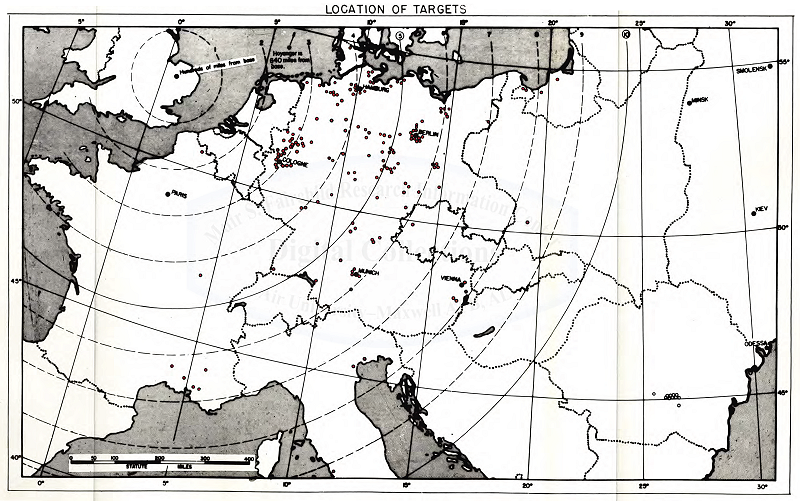TARGET SYSTEMS |
|||
|
Appendix |
System of Targets |
Number of Targets |
Percentage of Total Production Represented by Targets |
|
G I |
Pursuit Airplane Ass. Plant |
11 |
100 |
|
G II |
Bomber Airplane Ass. Plant |
15 |
100 |
|
G III |
Aero-engine Plants |
17 |
100 |
|
G IV |
Submarine Yards |
20 |
100 |
|
G V |
Transportation |
38 |
41.9 Loc.Bldg. |
|
G VI |
Power |
37 |
– – – |
|
G VII |
Oil |
23 |
47.0 |
|
G VIII |
Alumina |
14 |
100 |
|
G IX |
Rubber |
2 |
47.5 |
|
|
Total Number of Targets |
177 |
|
|
NOTES: 1. The systems are arranged in the order in which it is suggested they be attacked. 2. The first three systems relate to the German Air Force. In all cases the targets selected include 100% of the total output. If these targets were destroyed, Germany’s airplane building program would be brought to a standstill and her offensive and defensive air operations would rapidly decline as and when her operational airplanes were destroyed after using up any reserve. In the case of pursuit airplanes, Germany is known to have very few reserves. 3. The fourth system relates to U-boats and the targets include 100% of present production. If these targets were destroyed, Germany’s U-boat shipbuilding program would be brought to a standstill and the U-boat campaign would be gradually reduced as and when her operational subs were rendered inoperative. This would be accelerated by virtue of the fact that by destroying the yards all major servicing and repair facilities to operational U-boats would similarly cease. 4. The fifth system relates to transportation and covers locomotive building plants, locomotive repair shops, marshalling yards, and inland waterways. It is well known that Germany is extremely short of locomotives at present and the destruction of the repair facilities and concentrations of locomotives which might be found in those works would disrupt her general transportation system. This system is complementary to other systems in that it would prevent the diversion of raw materials to new centers of production when the original centers were destroyed. 5. The destruction of objectives in the sixth class – power – cannot be expressed quantitatively but if each of the thirty-seven (37) targets included were destroyed, industry would be very largely brought to a standstill and the effect on morale would be very great. 6. The remaining systems - oil, alumina, and rubber - represent three of the major commodities required by Germany in the prosecution of her war effort. 7. There is no doubt that if the targets included in these systems were successfully destroyed, the effect would be decisive and Germany would be unable to continue her war effort. |
|||
LOCATION OF TARGETS

|
BOMBER FORCE REQUIRED |
||||
|
Appendix |
System of Targets |
Total Number of Sorties Required |
Operation Bomber Force Required |
Total Bomber Force Required |
|
G I |
Pursuit Airplane Ass. Plants |
6,318 |
216 |
288 |
|
G II |
Bomber Airplane Ass. Plants |
8,424 |
284 |
379 |
|
G III |
Aero-engines Plants |
7,632 |
256 |
341 |
|
G IV |
Submarine Yards |
10,332 |
347 |
462 |
|
G V |
Transportation |
9,348 |
314 |
418 |
|
G VI |
Power |
13,449 |
452 |
603 |
|
G VII |
Oil |
8,322 |
280 |
373 |
|
G VIII |
Alumina |
1,932 |
65 |
87 |
|
G IX |
Rubber |
288 |
11 |
14 |
|
|
TOTAL |
66,045 |
2,225 |
2,965 |
|
BOMBER FORCE |
||||
|
|
Heavy Bombers B 17e's |
Medium Bombers |
||
|
Number of Groups |
42 |
15 |
||
|
Number of Bombers per Group |
48 |
63 |
||
|
Total Number of Bombers - in class |
2,016 |
945 |
||
|
Total Number of Bombers |
2,961 |
|||
|
Number of Operational Bombers (i.e. less approx. 25%) |
1,512 |
720 |
||
|
Total Number of Operational Bombers |
2,232 |
|||
|
NOTES: 1. In calculating the number of bombers required to make a given number of sorties over a target an allowance of fifteen (15) percent has been made for bombers which are dispatched but do not attack the target. 2. The number and weight of bombs required to be dropped on each target have been calculated according to the vulnerability and area of the target. They vary between 300 lb. and 1000 lb. bombs. 3. The prosecution of this complete plan involves the dropping of a total of about two hundred seventy-three (273,000,000) million pounds of bombs. 4. This plan is to be carried out in a period of six months during which thirty-five (35) days should be favorable for operations. |
||||